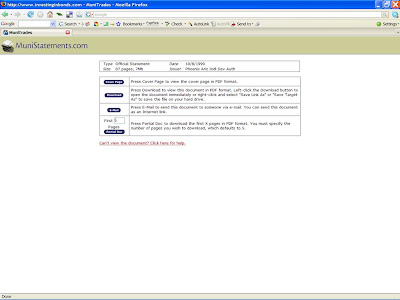 Introduction
Introduction
In the previous post, we discussed how to obtain an official statement on a municipal bond issue. Now, we will explore various areas of relative importance on the cover sheet of an OS. The particular Official Statement used in this analysis is the Glendale Arizona Industrial Development Authority Hospital Revenue and Refunding Issue dated in 2007 (The file can be downloaded here). On this document, there are numbers next to the highlighted information that can be used as a guide. Throughout this post, we will explain various parts on the cover page of this Official Statement.
Please note: Not all OS’s are created the same. These sections are not necessarily in the same order as other Official Statements. The goal is to showcase the wide array of information on the cover of an OS.
Details
1. The upper right corner of this Official Statement is the rating(s) on the bond. Some issues may be non-rated (NR). The three largest rating agencies are:
a. Moody’s
b. S&P
c. Fitch
2. There is an opinion from bond counsel on the exemption status for several areas of taxes:
a. Federal
b. State
c. Alternative Minimum Tax (AMT)
d. Corporations
3. This section contains:
a. the Size of the Deal
b. the Issuer
c. the Type of Issue (Revenue, General Obligation, Certificate of Participation, etc.)
d. the Particular Series
4. A few key points in this area are:
a. the quantity and increments in which the bonds can be purchased
b. the dates of the year in which interest is paid to the bondholder
5. A subject to redemption prior to maturity is noted in this section. More information about the provision can be found inside the OS.
6. This division consists of descriptions of the obligator, the trustee, and agreement specifications.
7. The Maturity Schedule for the various series of bonds is displayed which includes:
a. Due Date
b. Principal Amount
c. Interest Rate
d. Yield
e. CUSIP
8. This piece includes the specifics of who are not the obligators.
9. Investing in the municipal bonds involves various risks. These risks are disclosed within the Official Statement. The table of contents in the OS allows the reader to efficiently search for a variety of topics such as the risks involved in the municipal bond deal.
10. Appendices are mentioned in this section, which are located towards the conclusion of the OS and can include items such as:
a. General Information
b. Financial Statements
c. Certain Provisions
d. Opinion of Bond Counsel
11. This section notes various counsel involved in the municipal deal such as:
a. Bond Counsel
b. Disclosure Counsel
c. Financial Advisor(s)
12. The manager of the deal and co-managers (if applicable) are located in this segment. If an investor is interested in buying this deal, he/she should give their order to one of the managers.
13. The date the OS was created for distribution is included for recordkeeping purposes.
Conclusion
It is important to navigate through research material in an effective and efficient manner when evaluating potential investment opportunities. The cover page of an Official Statement includes valuable information on the bond issue, but is meant to be a supplement to the entire statement as opposed to a substitution when performing due diligence.








 As recently as 4/18, the market was pricing in an easing of 75 bp’s this year. This probability has now declined to a 0.0% chance. We believe this change in perception is the primary catalyst for the sell-off this month.
As recently as 4/18, the market was pricing in an easing of 75 bp’s this year. This probability has now declined to a 0.0% chance. We believe this change in perception is the primary catalyst for the sell-off this month.